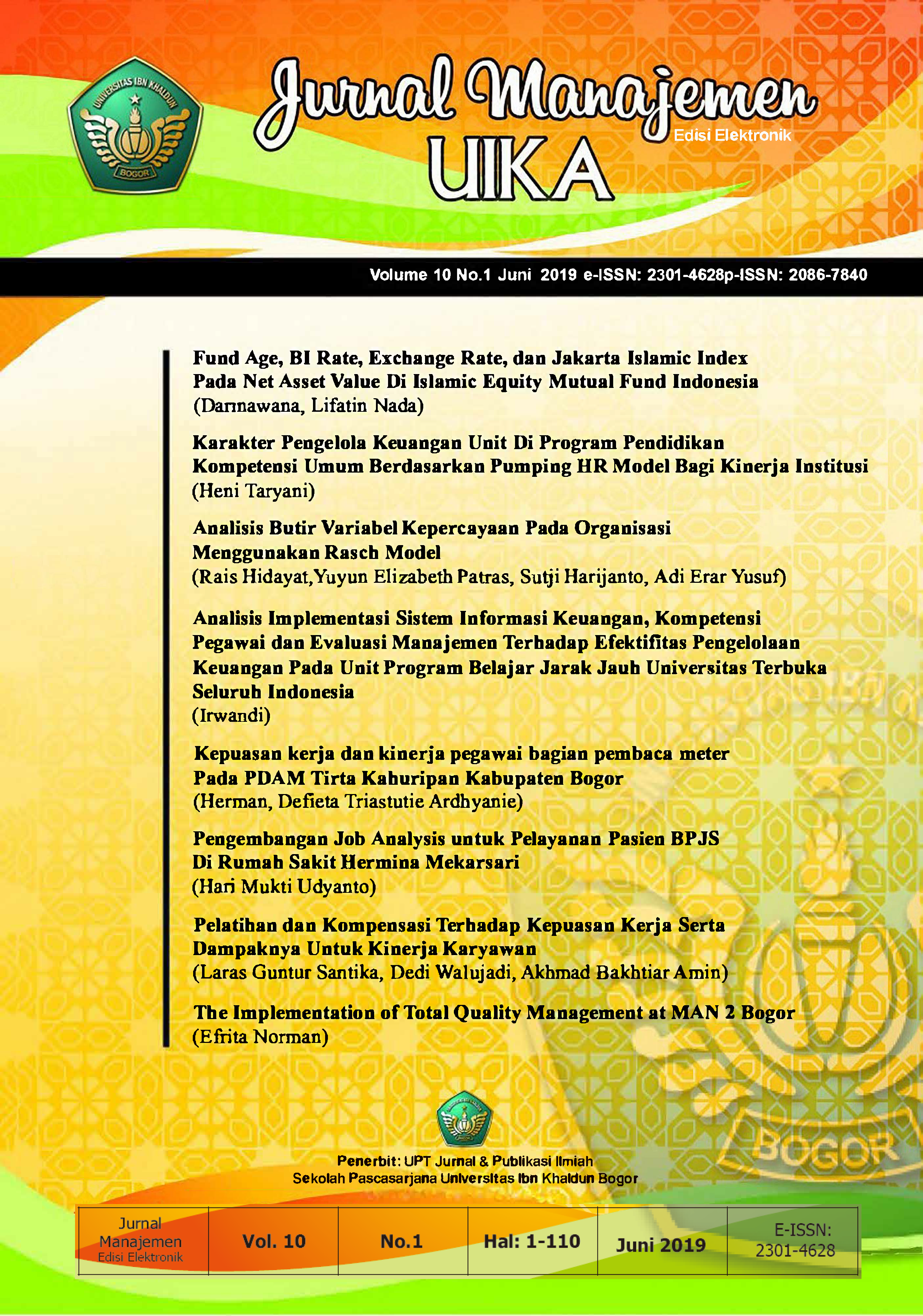Analisis Butir Variabel Kepercayaan Pada Organisasi Menggunakan Rasch Model
DOI:
https://doi.org/10.32832/jm-uika.v10i1.1894Keywords:
organizational trust, Rasch Model, Private UniversitiesAbstract
Organization trust is "lubricant" in the organization. This research aims to obtain instrument items that can be used in the organization trust research, to obtain the items that are difficult to approve and vice versa, and to obtain the perceptions of respondents on each instrument item. This research method uses to test the instrument items. The research was conducted at Private Universities in Bogor, West Java, Indonesia with a sample of 133 lecturers who had a National Lecturer Registration Number (NIDN) and had a functional position. Research findings include: as many as 28 out of 33 items can be used to examine organizations trust, and fair rewards, effective communication and involvement of lecturers in decision making are things that must be corrected at private universities. It is hoped that these findings will be a material for discussion to increase organizational trust.
References
Aguilar, H. C., Cortes, P. P., Guerrero, A. V, Herrera, C. D. C., & Orozco, J. A. T. (2011). Construction and Validation of an Instrument To Evaluate Critical Reading of Research Papers. 2011 4th International Conference of Education, Research and Innovation, (November), 5286–5294.
Bambang Sumintono, W. W. (2014). Aplikasi Model Rasch Untuk Penelitian Ilmu-Ilmu Sosial. Cimahi: Trim Komunikata.
Bambang Sumintono, W. W. (2015). Aplikasi Pemodelan Rasch pada Asesment Pendidikan. Cimahi: Trim Komunikata.
Bond, T. G., & Fox, C. M. (2007). Applying the Rasch Model?: Fundamental Measurement in the Human Sciences Second Edition University of Toledo. New Jersey 07430: Lawrence Erlbaum Associates, Inc.
Brinkman, W.-P. (2009). Design of a Questionnaire Instrument. Handbook of Mobile Technology Research Methods, (December), 31–57.
Carvalho, L. D. F., Primi, R., & Meyer, G. J. (2012). Application of the Rasch model in measuring personality disorders. Trends, 34(2), 101–109.
Coulter, Stephen P. Robbins, M. (2010). Management. New York: Pearson.
David L. Goetsch, S. D. (2013). Quality Management for Organizational Excellence, Introduction to Total Quality Management. Boston: Pear.
Debra L. Nelson, J. C. Q. (2006). Organizational Behavior. Foundations, Realities and Challenges. Ohio: Thomson.
Hendriks, J., Fyfe, S., Styles, I., Skinner, S. R., Merriman, G., & Hendriks, J. (2012). Scale construction utilising the Rasch unidimensional measurement model?: A measurement of adolescent attitudes towards abortion. Australasian Medical Journal [AMJ 2012, 5(5), 251–261.
Hsiao, A., Auld, C., & Ma, E. (2015). Perceived organizational diversity and employee behavior. International Journal of Hospitality Management, 48, 102–112. https://doi.org/10.1016/j.ijhm.2015.04.009
Linacre, J. M. (2010). Predicting Responses from Rasch Measures. JOURNAL OF APPLIED MEASUREMENT, 11(1), 1–10.
Lusher, D., Robins, G., Pattison, P. E., & Lomi, A. (2012). “ Trust Me ”: Differences in expressed and perceived trust relations in an organization. Social Networks, 34(4), 410–424. https://doi.org/10.1016/j.socnet.2012.01.004
Lussier, R. N. (2008). Human Relations in Organization. Boston: McGraw-Hill.
Michell, J. (1997). Quantitative science and the definition of measurement in psychology. British Journal of Pyhology (1997), 88, 355–383.
Ng, T. W. H. (2015). The incremental validity of organizational commitment , organizational trust , and organizational identi fi cation. Journal of Vocational Behavior, 88, 154–163. https://doi.org/10.1016/j.jvb.2015.03.003
NGUYEN THANH DONG, D. N. F. S. (2014). Applying the Rasch Model to Investigate Singapore Principals ’ Instructional Leadership Practices. Leading & Managing, 20(2), 1–26.
Robbins, B. G. (2016). From the general to the speci fi c?: How social trust motivates relational trust. Social Science Research, 55, 16–30. https://doi.org/10.1016/j.ssresearch.2015.09.004
Stef van Buuren, D. J. D. W. (2015). Measuring Psychosocial Impact of CBRN Incidents by the Rasch Model. JOURNAL OF APPLIED MEASUREMENT, 16(3).
Stephen P Robbins, T. A. J. (2013). Organizational Behavior Fifteenth Edition. New Jersey: Prentice Hall.
Stephen R. Covey, R. R. M. (2008). The Speed of Trust. New York: Free Press.
Tesio, Il. (2003). Measuring Behaviours And Perceptions?: Rasch Analysis As A Tool For Rehabilitation Research. J Rehabil Med, 35, 105–115.
Tobroni. (2012). Manajemen Dan Kepemimpinan Pendidikan Islam?: Mencari Format Baru Manajemen Yang Efektif. Jurnal Nadwa, 6(1), 7–32.
Wu, M., & Adams, R. (2007). Applying The Rasch Model To Psycho-Social Measurement A Practical Approach. Melbourne.: Educational Measurement Solutions.
Zanini, M. T. F., & Migueles, C. P. (2013). Trust as an element of informal coordination and its relationship with organizational performance. EconomiA, 14(2), 77–87. https://doi.org/10.1016/j.econ.2013.08.005
Zile-Tamsen, C. Van. (2017). Using Rasch Analysis to Inform Rating Scale. Research in Higher Education. https://doi.org/10.1007/s11162-017-9448-0
Downloads
Published
How to Cite
Issue
Section
License
Authors who publish with this journal agree to the following terms:
- Authors retain copyright and grant the journal right of first publication with the work simultaneously licensed under a Creative Commons Attribution-NonCommercial-ShareAlike 4.0 International License that allows others to share the work with an acknowledgement of the work's authorship and initial publication in this journal.
- Authors can enter into separate, additional contractual arrangements for the non-exclusive distribution of the journal's published version of the work (e.g., post it to an institutional repository or publish it in a book), with an acknowledgement of its initial publication in this journal.
- Authors are permitted and encouraged to post their work online (e.g., in institutional repositories or on their website) prior to and during the submission process, as it can lead to productive exchanges, as well as earlier and greater citation of published work (See The Effect of Open Access).











